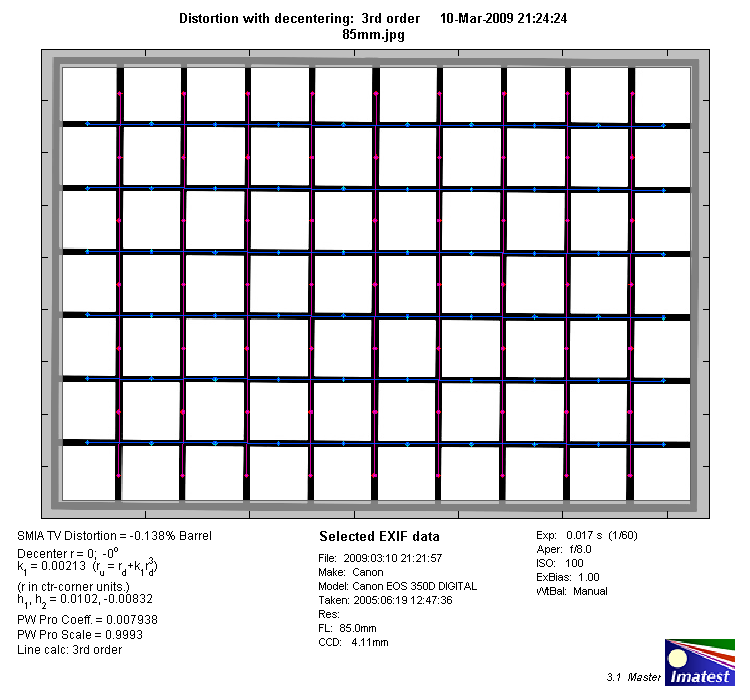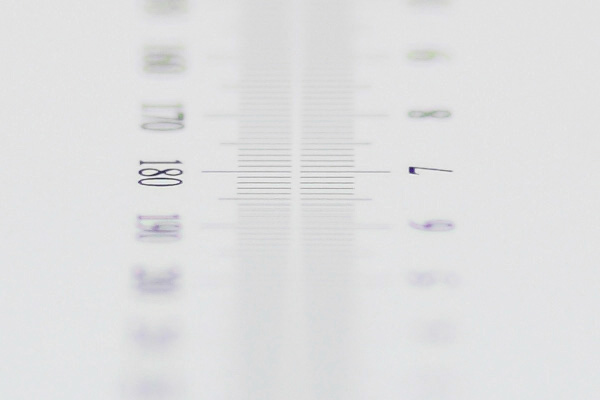|
Canon EF 85mm f/1.8 USM Retest @ 15mp / Review - Analysis |
|
Lens Reviews -
Canon EOS (APS-C)
|
|
Page 2 of 2

Distortion
As expected for a fix-focal lens the level of distortion is absolutely negligible in field conditions (~0.14%).

The chart above has a real-world size of about 120x80cm. The chart of the initial test has been reused because this characteristic cannot change by moving to a different APS-C DSLR.
Vignetting
On APS-C DSLRs full format lenses enjoy a sweet spot advantage (center crop) so vignetting is usually a non-issue. This is also true for the EF 85mm f/1.8 USM which shows only a moderate degree of vignetting at f/1.8 (0.7EV) and no relevant vignetting at all other tested settings.

MTF (resolution)
The EF 85mm 1.8 USM is a more than impressive performer when it comes to resolution. It is capable of producing a very high quality straight from f/1.8 across the APS-C image frame. The excellent peak is reached between f/5 and f/5.6. The lens shows no field curvature problems whatsoever. This tested sample was marginal superior compared to the one used in the initial test of the lens back in 2005.
Please note that the MTF results are not directly comparable across the different systems!
Below is a simplified summary of the formal findings. The chart shows line widths per picture height (LW/PH) which can be taken as a measure for sharpness.
If you want to know more about the MTF50 figures you may check out the corresponding Imatest Explanations
Chromatic Aberrations (CAs)
Lateral chromatic aberrations (color shadows at harsh contrast transitions) are a non-issue at all tested aperture
settings.

Bokeh Fringing (Longitudinal Chromatic Aberrations (LoCA))
LoCAs (non-coinciding focal planes of the various colors) are a primarily problem with ultra-fast prime lenses and the EF 85mm f/1.8 USM suffers quite a bit here as well. At f/1.8 the greenish and magenta focus halos are very obvious. The situation improves slowly towards f/2.8 but you can still spot traces of bokeh fringing at f/4 although it's not disturbing anymore here. This is all not unusual but it's not desirable either.
|
Move the mouse cursor over the f-stop marks below to observe the respective LoCAs
|
| f/1.8 |
f/2.8 |
f/4 |
|

|
Note: the results of the full format tests have been reused here.
Bokeh (out-of-focus blur)
The quality of the bokeh is very good at f/1.8 with evenly rendered circular highlights and smooth contrast transitions. However, the mentioned bokeh fringing is also pretty obvious in our test scene - see e.g. the greenish halo in the sample crop taken at the statue. At the very outmost image portions highlights loose their circular shape towards an elliptical form. The lens does not feature circular aperture blades - this is no problem at max. aperture but you are already getting slightly octagonal highlights at f/2.8 and more so at f/4.

Note: the results of the full format tests have been reused here.
Purple Fringing
We've already reported the problem before but the EF 85mm f/1.8 USM is somewhat prone to purple fringing at extreme contrast transitions. The issue is primarily limited to f/1.8 so you can work around it in critical scenes.

Note: the results of the full format tests have been reused here.
VerdictThe Canon EF 85mm f/1.8 USM is a very desirable lens and, surprisingly, a very affordable one. Both contrast and resolution are very good straight from f/1.8 and excellent at medium aperture settings. On APS-C DSLRs there's only a moderate degree of vignetting at f/1.8 and beyond it's a non-issue. Neither distortions nor lateral CAs are something to worry about in field conditions. However, bokeh fringing (LoCAs) can be visible in some scenes and in extreme situations you may also spot some purple fringing. The quality of the bokeh is generally very good at f/1.8 (apart from the LoCA problems) but the lack of circular aperture blades shows up in out-of-focus highlights when stopping down. The build quality of the lens is very good and the AF performance leaves nothing to be desired.
Highly recommended!
|